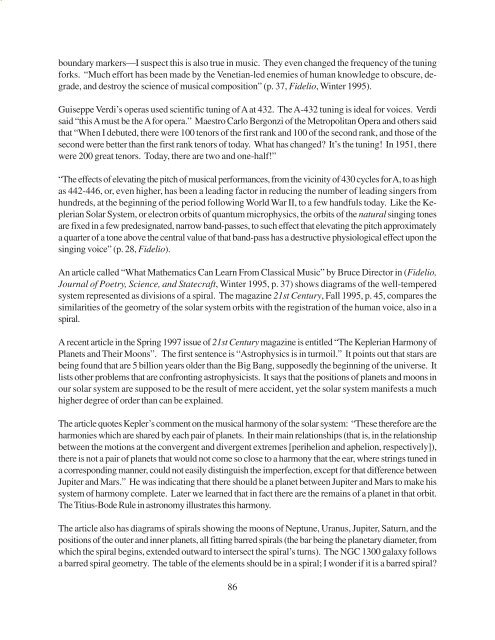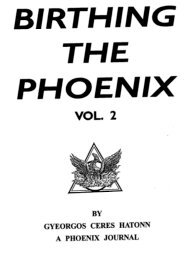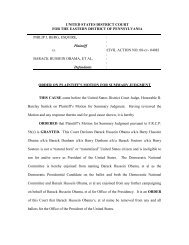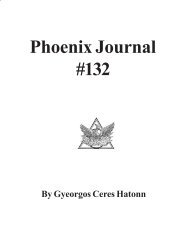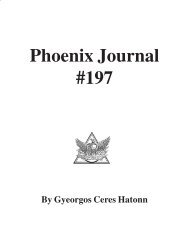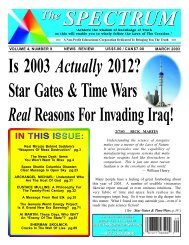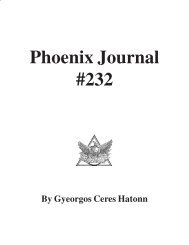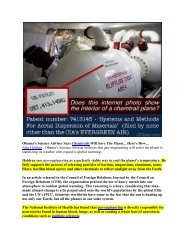Phoenix Journal 208 - Four Winds 10
Phoenix Journal 208 - Four Winds 10
Phoenix Journal 208 - Four Winds 10
You also want an ePaper? Increase the reach of your titles
YUMPU automatically turns print PDFs into web optimized ePapers that Google loves.
oundary markers—I suspect this is also true in music. They even changed the frequency of the tuning<br />
forks. “Much effort has been made by the Venetian-led enemies of human knowledge to obscure, degrade,<br />
and destroy the science of musical composition” (p. 37, Fidelio, Winter 1995).<br />
Guiseppe Verdi’s operas used scientific tuning of A at 432. The A-432 tuning is ideal for voices. Verdi<br />
said “this A must be the A for opera.” Maestro Carlo Bergonzi of the Metropolitan Opera and others said<br />
that “When I debuted, there were <strong>10</strong>0 tenors of the first rank and <strong>10</strong>0 of the second rank, and those of the<br />
second were better than the first rank tenors of today. What has changed? It’s the tuning! In 1951, there<br />
were 200 great tenors. Today, there are two and one-half!”<br />
“The effects of elevating the pitch of musical performances, from the vicinity of 430 cycles for A, to as high<br />
as 442-446, or, even higher, has been a leading factor in reducing the number of leading singers from<br />
hundreds, at the beginning of the period following World War II, to a few handfuls today. Like the Keplerian<br />
Solar System, or electron orbits of quantum microphysics, the orbits of the natural singing tones<br />
are fixed in a few predesignated, narrow band-passes, to such effect that elevating the pitch approximately<br />
a quarter of a tone above the central value of that band-pass has a destructive physiological effect upon the<br />
singing voice” (p. 28, Fidelio).<br />
An article called “What Mathematics Can Learn From Classical Music” by Bruce Director in (Fidelio,<br />
<strong>Journal</strong> of Poetry, Science, and Statecraft, Winter 1995, p. 37) shows diagrams of the well-tempered<br />
system represented as divisions of a spiral. The magazine 21st Century, Fall 1995, p. 45, compares the<br />
similarities of the geometry of the solar system orbits with the registration of the human voice, also in a<br />
spiral.<br />
A recent article in the Spring 1997 issue of 21st Century magazine is entitled “The Keplerian Harmony of<br />
Planets and Their Moons”. The first sentence is “Astrophysics is in turmoil.” It points out that stars are<br />
being found that are 5 billion years older than the Big Bang, supposedly the beginning of the universe. It<br />
lists other problems that are confronting astrophysicists. It says that the positions of planets and moons in<br />
our solar system are supposed to be the result of mere accident, yet the solar system manifests a much<br />
higher degree of order than can be explained.<br />
The article quotes Kepler’s comment on the musical harmony of the solar system: “These therefore are the<br />
harmonies which are shared by each pair of planets. In their main relationships (that is, in the relationship<br />
between the motions at the convergent and divergent extremes [perihelion and aphelion, respectively]),<br />
there is not a pair of planets that would not come so close to a harmony that the ear, where strings tuned in<br />
a corresponding manner, could not easily distinguish the imperfection, except for that difference between<br />
Jupiter and Mars.” He was indicating that there should be a planet between Jupiter and Mars to make his<br />
system of harmony complete. Later we learned that in fact there are the remains of a planet in that orbit.<br />
The Titius-Bode Rule in astronomy illustrates this harmony.<br />
The article also has diagrams of spirals showing the moons of Neptune, Uranus, Jupiter, Saturn, and the<br />
positions of the outer and inner planets, all fitting barred spirals (the bar being the planetary diameter, from<br />
which the spiral begins, extended outward to intersect the spiral’s turns). The NGC 1300 galaxy follows<br />
a barred spiral geometry. The table of the elements should be in a spiral; I wonder if it is a barred spiral?<br />
86


